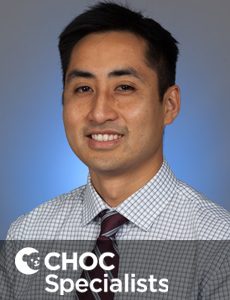Voice Disorders Program
Parents want their kids to live a successful and fulfilling life. Often, our voices play an essential role in finding that success and expressing ourselves to the world. The Voice Disorders Program at CHOC nurtures the gift of voice by treating various voice-related pediatric conditions with a multi-disciplinary team approach. We believe every child deserves to be able to communicate, connect and share their thoughts and feelings with the world.

Voice Disorder Conditions We Treat
The Voice Disorder Program at CHOC provides evaluations, treatments, surgical procedures and therapy services for many voice-related conditions. Conditions we treat include congenital larynx problems, stress- and injury-related voice changes, velopharyngeal dysfunction (palatal speech problems), sudden voice changes and more. Common conditions that we treat include:
Structural Abnormalities and Lesions
- Vocal Cord Nodules
- Vocal Polyps
- Vocal Cord Dysfunction (VCD)
- Cleft Palates And Craniofacial Abnormalities
Neurological and Functional
- Spasmodic Dysphonia
- Vocal Cord Paralysis.
- Soft Voice Syndrome
Inflammatory and Infectious
- Laryngitis
Talking and Articulation
- Velopharyngeal Insufficiency
- Cleft-Related Speech Issues
- Speech Disorders
Voice-Related Diagnostic Procedures
Your child will receive exams from an ENT (otolaryngology) specialist and a Speech-Language Pathologist during their diagnostic appointment. They will work together to evaluate your child’s vocal health using structural imaging, phonatory function assessments and observation during your visit. Our holistic approach considers every aspect of a child’s vocal health to support accurate diagnosis and targeted treatment plans.
Below are some tests that might occur during your first visit:
- Voice Handicap Index (VHI): Questionnaire gathering patient information about the vocal issue.
- Laryngoscopy: Examination of the larynx using a thin, flexible tube with a light and camera on the tip.
- Stroboscopy: A particular form of laryngoscopy that uses a strobe light to observe the vocal fold vibrations.
- Other Imaging: CT scans, MRIs or ultrasounds can provide detailed images of the larynx.
- Acoustic Analysis: A software analysis of recorded voice samples.
- Aerodynamic Assessment: The measurement of airflow and air pressure during speech.
Learn more about voice-related disorders causes, symptoms, and treatments.
Anatomy of Voice
The larynx, often called the voice box, is a complex tube-shaped organ located in the neck, right above the trachea (windpipe). It plays a crucial role in breathing, swallowing and talking.
Structure of the Larynx:
- Vocal Cords (Vocal Folds): Two muscle-controlled structures in the larynx. When you talk or sing, they come together and vibrate as air passes through them to create sound.
- Epiglottis: A little flap that covers the larynx when you swallow. It helps stop food and drink from entering your lungs.
- Cartilage: The larynx is made up of several pieces of cartilage that give it structure. This includes the thyroid cartilage (Adam’s apple), typically more prominent in males.
Functions of the Larynx:
- Voice: Vibrations from the vocal cords are crucial to sound production that creates our voice.
- Breathing: The tube-shaped structure allows air to pass from the mouth and nose to the lungs.
- Protection: The epiglottis and vocal cords work together to prevent food, liquids and other objects from entering our trachea or lungs.
Voice-Related Treatments at CHOC
Treating pediatric voice disorders requires an involved approach that incorporates behavioral, medical and sometimes surgical interventions. The underlying cause of the voice disorder, its severity and the child’s unique needs determine the treatment. Often combined, these treatments optimize your child’s voice function, facilitate effective communication and improve their overall quality of life. Here are several treatments used at CHOC to help resolve voice disorders:
- Voice Therapy
- Tracheal Shave: Shaving reduces the size of the Adam’s apple for a smoother, more feminine throat shape.
- Feminization Laryngoplasty: Surgery alters the larynx and vocal cords to help raise the pitch of the voice.
What to Expect: First Visit
Children are usually recommended to our program by their pediatricians, who may observe irregularities in their voices. However, we also welcome children without referrals. At your first appointment at the CHOC Voice Disorder Program, anticipate a comprehensive voice evaluation from our specialized pediatric otolaryngologist (ENT) from CHOC and a pediatric speech pathologist from the Providence Speech & Hearing Center. The insights gained from these initial tests aid our specialists in establishing an accurate diagnosis for your child. The insights gained from these initial tests aid our specialists in establishing an accurate diagnosis for your child.
Based on your child’s diagnosis, we assemble a team of multidisciplinary pediatric experts to tailor treatments to your child’s needs. This team may include pediatric otolaryngologists, speech pathologists, voice therapists, other specialized CHOC professionals and your child’s primary pediatrician.
It’s crucial to note that integrating our specialized plans with your child’s existing care and therapeutic routine is seamless. There is no need to replace current therapy plans, providers or pediatricians when joining our program. We’re committed to collaborating with all professionals, ensuring your child benefits from the most comprehensive, specialized and effective treatment available, located conveniently under one roof at CHOC.
Frequently Asked Questions
If your child's voice issues continue beyond three weeks, especially without a clear cause, like a cold, it's wise to see a specialist. Timely checks can help address potential voice disorders in children.
If your pediatrician recommends you see a specialist, you can learn more about rehabilitation assessments here.Meet our Team

Pham, Nguyen S. MD
Specialty:
Otolaryngology (ENT)
Appointments: 714-633-4020
Dr. Nguyen Pham is a board certified pediatric otolaryngologist (ENT) who treats ear, nose and throat problems in kids and performs head-and-neck surgery.

Su-Velez, Brooke M. MD
Specialty:
Otolaryngology (ENT)
Office: 714-633-4020
Dr. Su-Velez is a board certified otolaryngologist (ENT) who treats ear, nose and throat problems in kids and performs head-and-neck surgery.












